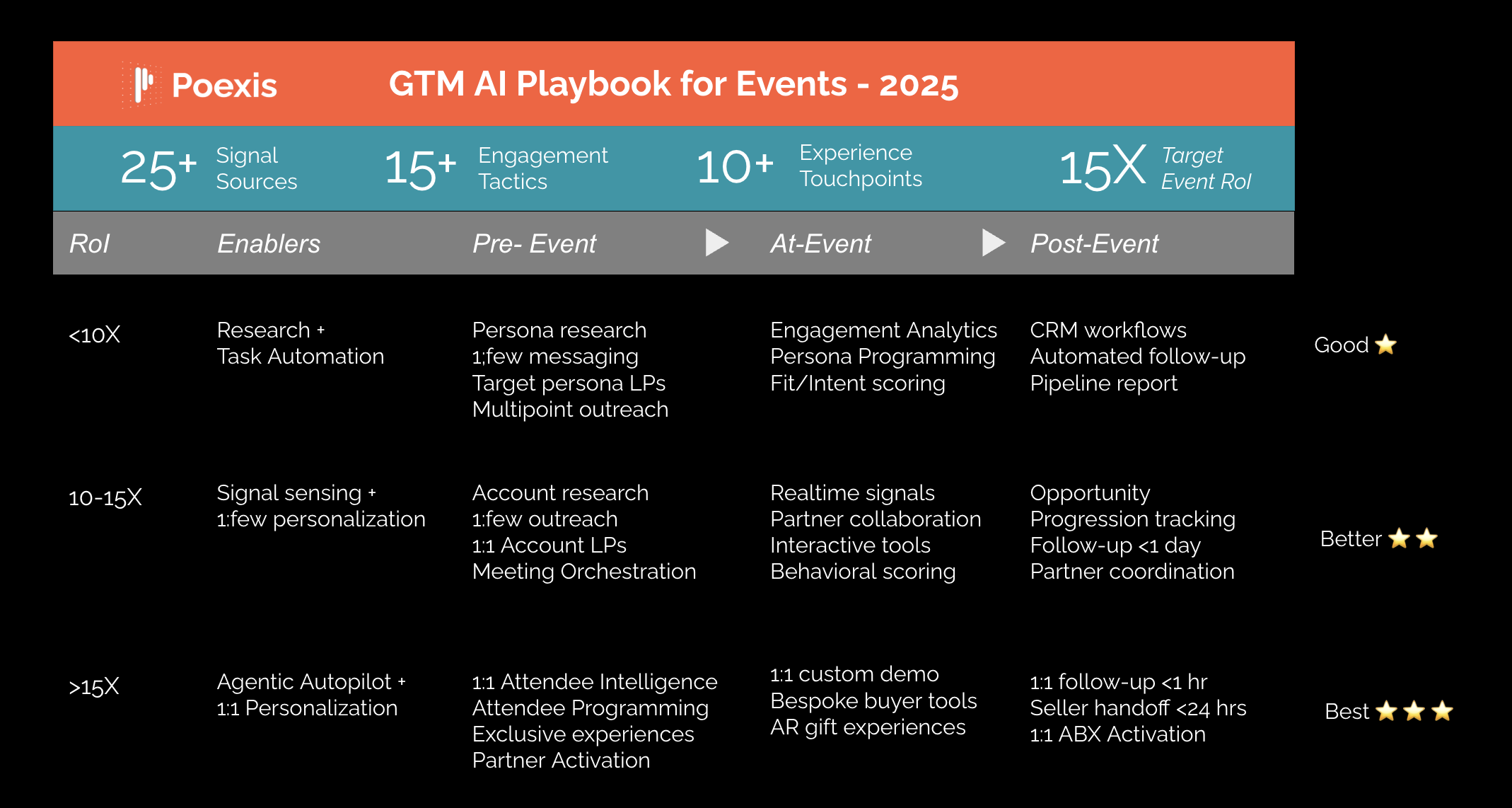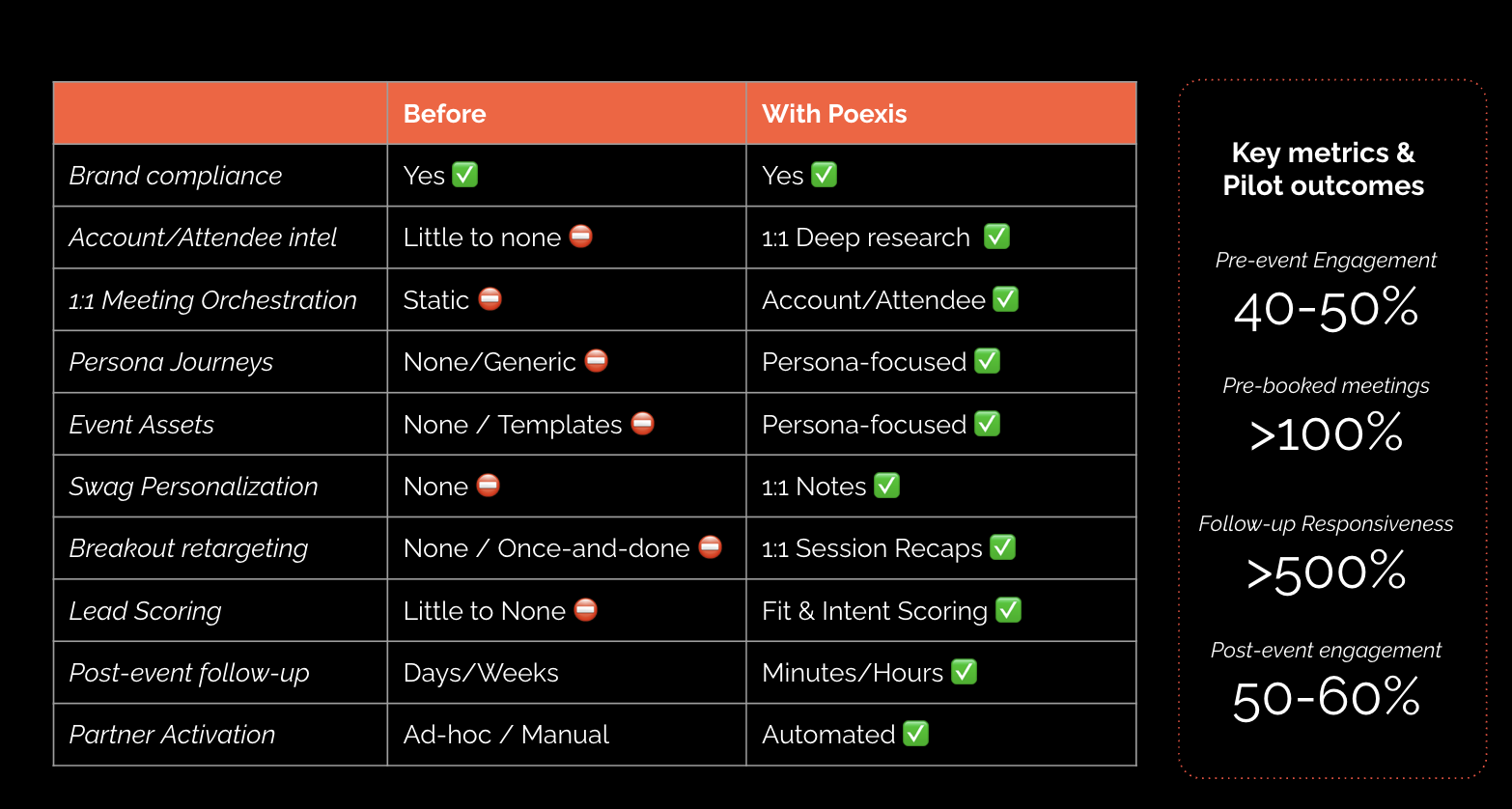How Growth Marketers Use AI to Accelerate Pipeline and Hyperpersonalize Event Experiences
TL;DR: Growth marketers are achieving 15-20x pipeline ROI from events by orchestrating AI agents for in-depth research, hyperpersonalization, and instant follow-up. With Poexis, you can run these campaigns in minutes - zero learning-curve, no bloated tech stack.
While buyers increasingly prefer in-person events and genuine human connection over digital touchpoints, most B2B marketing teams still struggle to prove meaningful event ROI. Now, a new demand generation playbook is emerging: using agentic AI to orchestrate hyperpersonalized event experiences that generate 15-20x pipeline returns while maximizing crucial top of funnel momentum and brand awareness.
Here’s how this new playbook sources deep intelligence from 25+ sources, automates work across a dozen touchpoints and drives outcomes pre-event, at-event and post-event stages.

There is a lot going on here, but before unpacking it, let’s take a step back and look at what’s broken today.
Why the traditional event playbook falls short
Unfortunately, most marketing teams still approach events like networking mixers from the 1990s: show up, shake hands, scan badges or collect business cards (remember them?), and hope something sticks. This spray-and-pray methodology might have worked when buyers had fewer options and less information, but today’s technology buyers expect personalized, relevant experiences at every touchpoint.
The fundamental problem is that traditional event marketing treats everyone the same. This spray-and-pray approach might have worked when buyers had fewer options, but today’s technology buyers expect personalized experiences at every touchpoint.
Three critical gaps that kill event ROI:
The Intelligence Gap: Most teams know little about attendees before the eventbeyond job titles at best. They’re flying blind into conversations without understanding specific challenges, recent company news, or buying context.
The Experience Gap: Generic demos and standard presentations fail to resonate. Attendees leave thinking “nice product, but not sure how it applies to us.”
The Follow-up Gap: Manual processes mean slow, generic follow-up. By the time teams send any outreach, the attention window has passed and attendees have moved on.
The result? Events become expensive awareness plays instead of pipeline engines. Teams measure success by booth traffic and lead volume instead of opportunity creation and revenue attribution.
The Three Stages in Agentic Demand Orchestration Playbook
Here’s how smart growth teams are using AI to transform their event strategy:
1. Pre-Event Intelligence & Orchestration
Instead of a generic event plan, AI agents:
- Conduct deep research on each target account or attendee
- Analyze company news, tech stack, and fit/intent signals
- Map the event attendees to the opportunities and pipeline in CRM
- Create personalized outreach sequences with relevant hooks
- Generate account-specific or better, attendee-specific landing pages
- Orchestrate highly targeted experiences: private demos, early previews, executive roundtables, etc. to drive engagement prior to the event
2. At-Event: Real-Time Personalization
Generic experiences give way to hyperpersonalized interactions. From every pixel on any screen to a personalized menu item or branded napkin folds at the exec dinner table, from interactive customer tools to fully custom demos - no detail or interaction is left out. For instance:
- Personalized, attendee-specific conversations
- 1:1 event experiences unlocked through check-in, instead of a badge scan
- Personalized gifts, instead of generic event swag
- Consultative demos aligned to uncovered challenges
- Interactive tools & spatial experiences for memorable engagement
- Instant partner activation when qualified prospects engage
3. Post-Event: Acceleration & Conversion
While competitors send generic follow-up emails a week later, AI agents
- Launch personalized follow-up campaigns within minutes
- Attendees receive custom content based on their interests: interactive journeys, customer studies, RoI calculators or technical deep-dives - not vanilla datasheets or case studies invites.
- Intelligent handoffs to sales with conversation summaries & next-step plans
- Account-based experiences triggered for high-value prospects
Let’s look at a real-world example of how this works in practice.
Example: SaaS Vendor at a Tradeshow
A SaaS vendor with a booth and breakout sessions replaces generic lead scans with Poexis-powered orchestration:
- Before: Badge scans, static booth deck, generic follow-up
- After: Deep pre-event research, tailored demos, instant follow-up campaigns, partner co-engagement

Why This Works Now
If this sounds too good to be true, consider what’s fundamentally changed in the AI landscape over the past 12-18 months. Poexis has assembled specific Agentic OS capabilities leveraging these advancements rather than bolting on as a co-pilot to existing SaaS tools.
State-of-the-Art models with context: Poexis uses best-in-class models like Claude, GPT-4, and Gemini depending on the nature of the agentic task - such as analyzing attendee profiles, understanding competitive dynamics, and generating contextually appropriate outreach—all while providing carefully defined context and enforcing brand and safety guardrails along with cost controls as part of its system-level services.
Tool Ecosystem: Modern AI agents seamlessly connect with your existing tech stack through APIs and emerging standards like Model Context Protocol (MCP). They can pull data from Salesforce, update HubSpot records, generate personalized videos, create 1:1 hyperpersonalized landing pages, and coordinate calendar scheduling—all without human intervention. The integration complexity that once required engineering teams now happens through natural language in Poexis agents and agentic workflows.
Agentic Reasoning & Coordination: The breakthrough isn’t just individual AI capabilities - it’s agents that can reason together and coordinate complex workflows. One agent handles research while another manages content creation and a third designs the engagement plan. Poexis orchestrates these agents real-time, they reason to make judgment calls with optional human-in-the-loop callouts, and work towards the outcomes.
The result? What required teams of marketers, ops, researchers, and content creators several months now happens in seconds using Poexis.
Next Steps
If your events still run on badge scans, static demos, and two-week follow-ups, you’re leaving significant pipeline and awareness on the floor. A pilot over the next 90 days could change that and double your pipeline. Book your free 30-min strategy session to run this playbook at your next event.